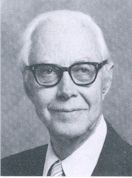Stephen Rice: Difference between revisions
No edit summary |
m (Text replace - "[[Category:Scientific tools and discoveries" to "[[Category:Engineering fundamentals") |
||
| (One intermediate revision by the same user not shown) | |||
| Line 21: | Line 21: | ||
Dr. Rice's work had an extended influence through the younger research workers to whom he has taught his methods. He and his wife, Inez, had one son and two daughters. Dr. Rice passed away on 18 November 1986. | Dr. Rice's work had an extended influence through the younger research workers to whom he has taught his methods. He and his wife, Inez, had one son and two daughters. Dr. Rice passed away on 18 November 1986. | ||
[[Category:People and organizations|Rice]] [[Category: | [[Category:People and organizations|Rice]] [[Category:Engineering fundamentals|Rice]] [[Category:Mathematics|Rice]] [[Category:Signals|Rice]] [[Category:Noise|Rice]] [[Category:Communications|Rice]] [[Category:Communication systems|Rice]] [[Category:News|Rice]] | ||
Revision as of 16:32, 22 July 2014
Biography
Born: 29 November 1907
Died: 18 November 1986
Stephen O. Rice was born November 29, 1907, in Shedds, Oregon. He received the B. S. degree in electrical engineering from Oregon State College, Corvallis, in 1929 and carried out graduate work at California Institute of Technology and at Columbia University. In 1961 he received the honorary degree of Doctor of Science from Oregon State College.
Following his graduate study, he joined Bell Telephone Laboratories as a Member of Technical Staff. From 1930 until 1968, Dr. Rice served Bell Labs as a consultant on transmission engineering and carried out research in communication theory. From 1968 until his retirement in 1972, he served as Head of the Communications Analysis Research Department where he was concerned with various aspects of communication theory, particularly those areas involving random phenomena and noise. After he retired from his long career at Bell Labs, he was a research physicist in the Department of Electrical Engineering and Computer Science at the University of California, San Diego.
Contributions to Communication Theory
Dr. Rice was one of the giants in the development of communication theory. His career was marked by extraordinary technical contributions to the scientific basis of telecommunications. His more than 60 papers included major contributions in the fields of noise theory, frequency modulation, nonlinear systems, and communication theory. To these could be added significant work in such areas as scattering from rough surfaces, propagation, traffic theory, transmission and wave-guide theory, and mathematics.
Dr. Rice's paper on "Mathematical Analysis of Random Noise," published in 1944 and 1945, is a classic in its field. It has had immense scientific and engineering influence not only on electrical communications, but also on other fields of engineering where random processes are important. In addition to his engineering achievements, Dr. Rice proved himself to be an exceedingly able mathematician and made many contributions to applied mathematics as a spin- off from his engineering investigations.
Dr. Rice was a member of the National Academy of Engineering and is a Fellow of the IEEE. During 1958 he served as a Gordon McKay Visiting Lecturer in Applied Physics at Harvard University. He was the recipient of the 1965 Mervin J. Kelly Award of the IEEE for his outstanding contributions in the field of communications and in 1974 received the Outstanding Contribution Award of the IEEE National Telecommunications Conference.
From the outset, Dr. Rice's work was characterized by depth, breadth, and an uncanny ability of getting directly to the essence of the engineering problem of interest Common threads running throughout his work include applications of probability and random process theory, electromagnetic theory, nonlinear theory, special functions, and asymptotic methods. Dr. Rice won the 1983 IEEE Alexander Graham Bell Medal "For his contributions to the fundamental understanding of communications systems and to the underlying mathematics, and for inspiring younger scientists and engineers. "
Dr. Rice's work had an extended influence through the younger research workers to whom he has taught his methods. He and his wife, Inez, had one son and two daughters. Dr. Rice passed away on 18 November 1986.
